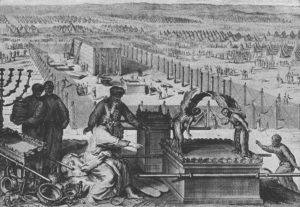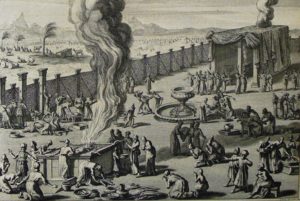“These things were done exactly as the Lord had commanded Moses.”
by Fr. William Rock, FSSP

After the Hebrews left Egypt, Moses ascended Mount Sinai while the people remained below. On the Mount, God showed Moses the plan for the Ark of the Covenant, the Tabernacle, and the liturgical instruments which the Children of Abraham were to use in the worship of the One, True, and Living God – “According to all the likeness of the tabernacle which I will shew thee, and of all the vessels for the service thereof: and thus you shall make it” (Exo 25:9).1
The Tabernacle consisted of a court, open to the sky, whose perimeter was marked by hanging curtains. As one moved from the entrance of the court, on the eastern side, one would encounter the brass-covered wooden altar of holocaust, then the basin for washing (the laver), and finally the Tent. The interior of the Tent was divided into two parts by a hanging veil. The area immediately inside the entrance of the Tent, called the Holy Place, contained the oil lampstand to the left as one entered, the table for the Show Bread to the right, and the altar of incense ahead. Beyond the veil, in the Holy of Holies, was the Ark of the Covenant with its two Cherubim. The Ark itself was considered God’s footstool (see 1 Par [Chr] 28:2; Pss 98:5, 131:7-8 [Vulgate numbering]). If the Ark was His footstool, then it follows that God was symbolically present in the space over the Ark. Indeed, from the space over the Ark, between the Cherubim, God would speak to Moses (Num 7:89).2

As one moves out again, an order is recognized. The space over the Ark from where God speaks is a special sign of God’s presence among His people – “In the beginning God…”.3 Under this sign of God’s presence are the two Cherubim atop the Ark. “The Fourth Lateran Council and the First Vatican Council declare: ‘at the beginning of time, [God] created at once out of nothing both orders of creatures, the spiritual and the corporeal, that is, the angelic and the earthy.'”4 – “…created heaven, and earth.”
Moving through the veil from the Holy of the Holies to the Holy Place, one encounters the altar of incense, possibly with still glowing coals, and the perpetually lit many-branched lampstand (see Ex 27:20-21) – “And God said: Be light made. And light was made…and there was evening and morning one day.”
As one steps out of the Holy Place, the sky is above, the ground below, and the laver filled with water ahead – “And God made a firmament, and divided the waters that were under the firmament, from those that were above the firmament, and it was so. And God called the firmament, Heaven; and the evening and morning were the second day…God also said; Let the waters that are under the heaven, be gathered together into one place: and let the dry land appear. And it was so done. And God called the dry land, Earth; and the gathering together of the waters, He called Seas. And God saw that it was good…And the evening and the morning were the third day.” During the day, the sun would shine over the court and the moon and stars would give their light at night – “And God made two great lights: a greater light to rule the day; and a lesser light to rule the night: and the stars…And the evening and morning were the fourth day.”
Beyond the laver is the altar of holocaust. This altar can be seen as representing the dry land separated from the seas (represented by the laver), or “the foundations of the earth, a symbolic association found throughout the biblical record, beginning with the ‘altar of earth,’ that Moses is commanded to build.”5 On this altar were offered sacrifices of birds – “God also said: let the waters bring forth the creeping creature having life, and the fowl that may fly over the earth under the firmament of heaven…And the evening and morning were the fifth day.” – and sacrifices of land animals – “And God said: Let the earth bring forth the living creature in its kind, cattle and creeping things, and beasts of the earth, according to their kinds. And it was so done…And the evening and morning were the sixth day.” Plants, which were created on the third day, were not excluded from the plan of the Tabernacle. The Show Bread was perpetually set in the Holy Place before the Presence of God. Olive oil burned in the lampstand. There were libations of wine, sacrificial cakes, and offerings of grain.6

Incredibly, the Ark, the Tabernacle, and its designated worship were designed by God to be a representation, a sign, of all of reality, of Himself and of His creation ordered to His service. “A canonical reading of Hebrew scripture indicates that God’s purposes in creating the world are liturgical. The world is made for worship. The covenant made in creation establishes the world as the temple and kingdom of God.”7 But, as this was obscured by the introduction of sin into the material world, God would, in the worship He commanded to be offered to Him by the Hebrews, remanifest it, even if only locally. This ordered creational worship commanded by God in the Tabernacle served as a reminder to fallen material creation of what its true purpose and end are.
In his work, The Kingdom of God as Liturgical Empire – A Theological Commentary on 1-2 Chronicles, Dr. Scott Hahn wrote the following touching on this subject:
The creation of the world in Gen. 1-2 is recounted in liturgical terms and ritual rhythms, unfolding in a heptadic patter, with a series of repeated sevens – beginning with the first verse, which contains exactly seven words in Hebrew, and proceeding with seven clearly defined creative speech-acts of God (“and God said, ‘Let…’”), seven statements of divine approval (“It was good”), and culminating in the divine rest of the seventh day…This same heptadic pattern is found in the account of the tabernacle. Moses’s time on the mountain can be seen as a kind of new creation. The cloud of divine presence covers the mountain for six days; on the seventh day Moses is called into the cloud to receive the divine blueprint (tabnît) for the tabernacle (Exod. 24:15-16; 25:8-9). The instruction that God gives him are delivered in seven speeches (introduced by “the LORD said” or “the LORD spoke”;…), the last of which commands the observance of the Sabbath as a “perpetual covenant” and a “sign…that in six days the LORD made heaven and earth, and on the seventh day he rested” (31:16-17…). On a closer reading, the creation-tabernacle connections are even more apparent…:
And God saw everything that he had made, and behold, it was very good. (Gen. 1:31)
And Moses saw all the work, and behold, they had done it. (Exod. 39:43)Thus the heavens and the earth were finished. (Gen .2:1)
Thus all the work of the tabernacle of the tent of meeting was finished. (Exod. 39:32)On the seventh day God finished his work which he had done. (Gen. 2:2)
So Moses finished the work. (Exod. 40:33So God Blessed the seventh day. (Gen 2:3)
And Moses blessed them. (Exod. 39:43)8
Just as Catholic worship incorporates the astronomical worship of Eden, the post-Fall agricultural festivals, and the religious observances of the Old Law, so too does it, as the Tabernacle did, employ all of creation, all of reality, in the worship of God. No longer is God symbolically present by His footstool but is now substantially present in the Tabernacle containing the Blessed Sacrament. Images of the inhabitants of heaven – angels and saints – should fittingly adorn the church building. Candles give their light during the various liturgical ceremonies. Water is found in the holy water stoops. Water, wine, and bread are offered to God. Linen from flax plants dress the ministers and altar and is the material of the pall, corporal, and purificator. Animals are represented by the bees and silkworms – “creeping things” of the sixth day – which provide the wax and silk for the candles and vestments. Stained glass windows let in the natural light of the sun, moon, and stars. The altar, stone.9
There is still one portion of creation, however, the portion of creation which makes the worship of the material world rational (see Rom 12:1) and befitting the God Who is to be adored “in spirit and in truth” (Joh 4:23), which has not yet been addressed – “And God created man to his own image: to the image of God he created him: male and female he created them.” But this treatment will be for another time.
William Rock, FSSP was ordained in the fall of 2019 and is currently assigned to Regina Caeli Parish in Houston, TX.
- The instructions given by God and the construction are recounted in the Book of Exodus, chapters 25-40.
- The Ark itself can also be seen as a special presence of God. See Hanh, Scott W. The Kingdom of God as Liturgical Empire – A Theological Commentary on 1-2 Chronicles. (Grand Rapids: Baker Publishing Group, 2012), 119.
- The quotes concerning God’s creation throughout are taken from Genesis, Chapter 1.
- Denzinger, Henry. The Sources of Catholic Dogma [1954]. (Fitzwilliam: Loreto Publications, 2010), §26.
- Hahn, 118.
- See The Levitical Offerings And Sacrifices for a summary of the various sacrifices commanded by God.
- Hahn, 120.
- Hahn,115-116.
- Until recently, the table/mensa and supports of a fixed altar were to be made of stone. Otherwise, a stone containing the relics of martyrs and consecrated by a Bishop was necessary (see Matters Liturgical nn. 71-75). The General Rubrics of the 1962 Missal state the following: “525. The altar on which the most holy sacrifice of the Mass is to be celebrated must be wholly of stone, and duly consecrated; or at least it must have a stone slab, or an altar stone, likewise duly consecrated, large enough to hold the host and the greater part of the chalice; or again, by apostolic indult, an antimension [a piece of linen containing relics], duly blessed” (translation taken from Divinum Officium).
June 14, 2022








